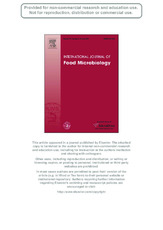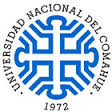- RDI Principal
- →
- Facultad de Ciencias Agrarias
- →
- Artículos
- →
- Ver ítem
JavaScript is disabled for your browser. Some features of this site may not work without it.
Mostrar el registro sencillo del ítem
| dc.creator | Robiglio, Andrea | |
| dc.creator | Sosa, María Cristina | |
| dc.creator | Lutz, María Cecilia | |
| dc.creator | Lopes, Christian A. | |
| dc.creator | Sangorrín, Marcela P. | |
| dc.date | 2011 | |
| dc.date.accessioned | 2019-12-19T15:48:25Z | |
| dc.date.available | 2019-12-19T15:48:25Z | |
| dc.identifier | http://rdi.uncoma.edu.ar/handle/uncomaid/15584 | |
| dc.identifier.issn | 0168-1605 | es_ES |
| dc.description.abstract | To reduce the use of fungicides, biological control with yeasts has been proposed in postharvest pears. Most studies of antagonists selection have been carried out at room temperature. However, in regions like North Patagonia where fruits are stored at − 1/0 °C during 5–7 months the selection of potential antagonist agents must be carried out at low temperature. In this study, 75 yeast cultures were isolated from healthy pears from two Patagonian cold-storage packinghouses. Aureobasidium pullulans, Cryptococcus albidus, Cryptococcus difluens, Pichia membranifaciens, Pichia philogaea, Rhodotorula mucilaginosa and Saccharomyces cerevisiae yeast species were identified. Additionally, 13 indigenous isolates of Penicillium expansum and 10 isolates of Botrytis cinerea were obtained from diseased pears, characterized by aggressiveness and tested for sensitivity to postharvest fungicides. The yeasts were pre-selected for their ability to grow at low temperature. In a first biocontrol assay using the most aggressive and the most sensitive isolate of each pathogen, two epiphytic isolates of A. pullulans and R. mucilaginosa were the most promising isolates to be used as biocontrol agents. They reduced the decay incidence by P. expansum to 33% and the lesion diameter in 88% after 60 days of incubation in cold. Foreign commercial yeast used as a reference in assays, only reduced 30% of lesion diameter in the same conditions. Yeasts were not able to reduce the incidence of B. cinerea decay. The control activity of the best two yeasts was compared with the control caused by the fungicides in a second bioassay, obtaining higher levels of protection against P. expansum by the yeasts. These two regional yeasts isolates could be promising tools for the future development of commercial products for biological control. | es_ES |
| dc.format | application/pdf | es_ES |
| dc.format.extent | pp. 211–216 | es_ES |
| dc.language | eng | es_ES |
| dc.publisher | Elsevier | es_ES |
| dc.publisher | ScienceDirect | es_ES |
| dc.relation.uri | https://www.sciencedirect.com/journal/international-journal-of-food-microbiology/vol/147/issue/3 | es_ES |
| dc.rights | Atribución-NoComercial-CompartirIgual 2.5 Argentina | es_ES |
| dc.rights.uri | https://creativecommons.org/licenses/by-nc-sa/2.5/ar/ | es_ES |
| dc.source | International Journal of Food Microbiology. Vol. 147 Núm. 3 (2011) | es_ES |
| dc.subject | Postharvest diseases | es_ES |
| dc.subject | Penicillium expansum | es_ES |
| dc.subject | Botrytis cinerea | es_ES |
| dc.subject | Pyrus communisL. | es_ES |
| dc.subject | Antagonists yeast | es_ES |
| dc.subject | Biocontrol | es_ES |
| dc.subject.other | Ciencias Agrarias y Forestales | es_ES |
| dc.title | Yeast biocontrol of fungal spoilage of pears stored at low temperature | es_ES |
| dc.type | Articulo | es |
| dc.type | article | eu |
| dc.type | acceptedVersion | eu |
| dc.description.fil | Fil: Sosa, María Cristina. Universidad Nacional del Comahue. Facultad de Ciencias Agrarias; Argentina | es_ES |
| dc.description.fil | Fil: Lutz, María Cecilia. Universidad Nacional del Comahue. Facultad de Ciencias Agrarias; Argentina | es_ES |
| dc.cole | Artículos | es_ES |



